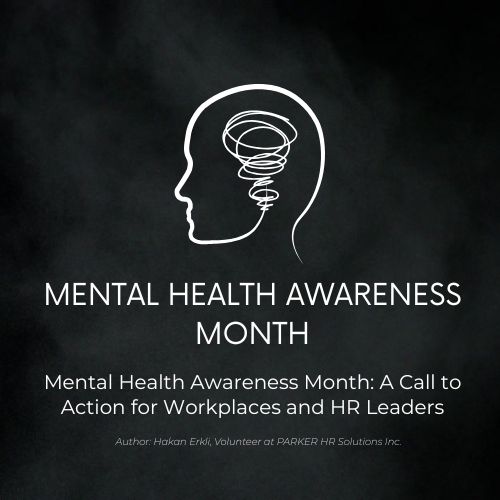Mental Health Awareness Month: A Call to Action for Workplaces and HR Leaders
Contributed by Hakan Erkli, Administrative Volunteer at PARKER HR Solutions Inc.

Each May, Mental Health Awareness Month serves as a powerful reminder that mental health is essential to overall well-being — and that stigma must never stand in the way of support. While public awareness is growing, the need for decisive and sustained action is underscored by compelling data showing just how pervasive and disruptive mental health challenges have become in our workplaces and communities.
According to the National Council for Mental Wellbeing (2025), one in five adults in both the United States and Canada experience a mental illness each year. In Canada alone, approximately 500,000 people are unable to work each week due to mental health issues (Canadian Mental Health Association, 2025). These numbers paint a clear picture: mental health is not only a public health issue, but also a significant workforce and economic concern. HR leaders, in particular, are called to respond with compassion, strategic planning, and long-term commitment to building psychologically healthy and inclusive workplaces.
The Case for Workplace Action
The workplace plays a pivotal role in shaping mental health outcomes. The Job Demands–Resources (JD-R) Model demonstrates that high job stress combined with low support leads to greater burnout and disengagement (Bakker & Demerouti, 2017). Similarly, Maslow’s Hierarchy of Needs — and its modern extensions — show that employees cannot perform or grow unless their foundational needs for safety, belonging, and psychological well-being are met (Kenrick et al., 2010). In other words, mental health support must not be treated as a workplace add-on. It must be embedded into how we lead, communicate, evaluate performance, and design our organizational cultures.
From Awareness to Action
Awareness is only the beginning. Workplaces must move beyond acknowledgment toward building environments that prioritize mental well-being. This starts with education and open dialogue. Sharing evidence-based information, challenging harmful stereotypes, and offering training on mental health literacy can reduce stigma and foster psychological safety.
Canadian employers are leading by example. Bell Canada’s Let’s Talk campaign has become a national model, funding dozens of mental health initiatives and promoting authentic, stigma-reducing conversations (Bell, 2024). PwC Canada trains its leaders to recognize early signs of mental distress and encourages regular check-ins with team members. At Lululemon, meditation rooms and mindfulness programming help integrate wellness into the workday.
These organizations demonstrate that authentic culture change requires both top-down commitment and grassroots participation.
Breaking Barriers to Care
Creating a culture of support also means removing practical barriers to care. This includes investing in robust Employee Assistance Programs (EAPs), ensuring benefit plans cover counseling and therapy, and offering flexible work arrangements or designated mental health days. Several Canadian employers are taking bold steps in this direction. Shopify offers unlimited wellness days and virtual access to mental health professionals, giving employees flexibility and autonomy. Sun Life has expanded its mental health coverage under its group benefits plan, signaling a commitment to whole-person care. Access, flexibility, and normalization are key pillars of an inclusive mental health strategy.
Engaging the Broader Community
HR’s role extends beyond internal policy. Employers can support national initiatives like Not Myself Today by the Canadian Mental Health Association, which helps organizations create engaging mental health campaigns tailored to the workplace. Companies can also amplify their impact by fundraising for local mental health organizations or encouraging employee volunteerism. Building resilience in the everyday work experience is equally important. Promoting movement breaks, offering mindfulness apps, creating peer support groups, and building wellness into workplace design are practical ways to foster a culture of care. When these habits become normalized, they contribute to long-term employee sustainability and retention.
Why HR Must Lead the Charge
In Canada, 30% of workplace disability claims are linked to mental illness (Government of Canada, n.d.). This staggering statistic illustrates why HR leaders must embed mental health into every stage of the employee experience — from onboarding and training to leadership development and performance reviews. One effective starting point is to conduct regular, anonymous well-being surveys to understand emerging needs and measure progress over time. Another is to recognize and reward employees who model mental health advocacy, helping to shift the cultural narrative and create safe spaces for vulnerability and openness. HR has the reach, influence, and data to lead mental health transformation — but it must be done with empathy, consistency, and measurable outcomes.
Let Us Move Beyond Awareness
As we observe Mental Health Awareness Month, we must remember that awareness alone is not enough. Mental health should be a year-round, organization-wide priority — not a seasonal campaign. It should be woven into the values, operations, and daily behaviors of every workplace. When we create psychologically safe, stigma-free environments, we do more than boost performance. We affirm the humanity of our people. We foster trust. And we signal that well-being is not a privilege — it is a foundation.
Let us lead with empathy. Let us act with intention. And let us create workplaces where mental health is not optional — it is essential.
Join the Conversation
If you are an HR professional, workplace leader, or passionate advocate for mental well-being, consider:
-
How is your organization supporting mental wellness in the workplace?
-
What changes would you like to see across your industry or community?
Use your voice. Share your stories. Let us build a movement that prioritizes people first.
References
Bakker, A. B., & Demerouti, E. (2017). Job demands–resources theory: Taking stock and looking forward. Journal of Occupational Health Psychology, 22(3), 273.
Bell. (2024). Bell Let’s Talk Community Fund announced 75 new grant recipients. https://letstalk.bell.ca/news/bell-lets-talk-community-fund-announced-75-new-grant-recipients/
Canadian Mental Health Association. (2025). Universal health care must include mental health. https://canadianlabour.ca/universal-health-care-must-include-mental-health/
Government of Canada. (n.d.). Mental health in the workplace. https://www.canada.ca/en/employment-social-development/services/health-safety/mental-health.html
Kenrick, D. T., Griskevicius, V., Neuberg, S. L., & Schaller, M. (2010). Renovating the pyramid of needs: Contemporary extensions built upon ancient foundations. Perspectives on Psychological Science, 5(3), 292–314.
National Council for Mental Wellbeing. (2025). Mental Health Awareness Month 2025. https://www.thenationalcouncil.org/mental-health-awareness-month/
